History of Chernihiv
Foundation of Chernihiv and its Golden Age
The first people settled in the territory of present-day Chernihiv about 6 thousand years ago. In the 1st millennium AD, on the steep banks of the Desna and Strizhnya, there were several settlements of the eastern Slavic tribe of the Northerners. The high bank of the Desna River, cut by deep ravines, was a natural fortification, which made it possible to simultaneously create several protected settlements in this area.
In the 7th century, further growth of these settlements led to their merger and the formation of a town occupying an advantageous geographical position in the wide basin of the Desna River. Along the Desna, it had a connection with Kyiv and further along the Dnieper with Byzantium. The Desna also opened access to the lands in the upper reaches of the Volga and Oka, as well as to Novgorod. In the late 9th century, it became the main center of the Northerners and joined Kyivan Rus’.
Chernihiv was first mentioned in the “Tale of Bygone Years” under 907, when the Kyiv Grand Prince Oleg, after a successful campaign against Byzantium, obliged the Greeks to pay tribute to the largest towns of Rus’. Chernihiv was mentioned in the agreement second after Kyiv.
In the second half of the 11th century, the growth of the town continued. In the 12th-13th centuries, during the fragmentation of Rus’, the old Chernihiv, being the center of a separate Chernihiv Princedom, reached its peak. With the population of about 40,000 people, it was one of the largest towns in Europe. During the 10th-13th centuries, Chernihiv was the second economic, political and cultural center of Kyivan Rus’ after Kyiv. Several churches of that time have survived to this day.
The development of Chernihiv was interrupted for a long time by the invasion of the Mongol Khan Batu. In October 1239, the Mongol army attacked Chernihiv. The town was turned into ruins, most of the residents were either killed or driven into slavery. The rest of the population of the principality went north. In December 1240, the Mongols captured Kyiv. Chernihiv lost its importance and Bryansk became the new center of the region (the Bryansk Principality).
More Historical Facts…
Chernihiv in the 14th-17th century
In the second half of the 14th century, Chernihiv was annexed to the Grand Duchy of Lithuania and was used as a southeastern outpost of the country. The town began to gradually revive. Chernihiv became a transit point not only for salt, resin and potash, but also for oriental goods: silk fabrics, carpets, brocade, fruits, and spices.
Following the results of the Russian-Lithuanian war of 1500-1503, Chernihiv became part of the Tsardom of Russia. Since Lithuania was not going to put up with the loss of this region, Chernihiv every now and then became the object of the Lithuanian military campaigns that took place during the numerous Russian-Lithuanian wars. In the middle of the 16th century, the garrison of the fortress was about 1,000 people.
In 1618, according to the Truce of Deulino, which ended the Russian-Polish war of 1609-1618, and, in a broad sense, the Time of Troubles in Russia, Chernihiv came under the control of the Polish-Lithuanian Commonwealth. In 1623, the Magdeburg Law was granted to Chernihiv by the Polish king Sigismund III. The Orthodox population living in the Polish-Lithuanian Commonwealth was subjected to national and religious oppression by the Poles, who professed Catholicism. This caused constant uprisings and their suppression.
In 1648, a major uprising broke out under the leadership of Bohdan Khmelnytsky (the Cossack-Polish War). The Chernihiv Cossack Regiment was created. According to the results of the Pereyaslav Council of 1654, Chernihiv again came under control of Russia, this time as part of the Cossack Hetmanate (the Zaporizhian Host).
Chernihiv in the 18th - early 20th centuries
During the Great Northern War (1700-1721), the Chernihiv Cossacks took part in the Battle of Poltava (1709) on the side of the Russian army of Peter I. After the victory, Peter I visited the Chernihiv fortress. On his instructions, additional guns were installed in the fortress. In 1799, the Chernihiv fortress was abolished. In 1899, the guns that remained in Chernihiv were placed on the edge of the rampart, where they still stand.
In 1801, Chernihiv became the capital of the then formed Chernihiv Governorate. Napoleon’s invasion of Russia in 1812 (through Poland, the territory of today’s Belarus and along the Smolensk road to Moscow) did not lead to the occupation of Chernihiv. Nevertheless, many residents of the town joined the ranks of the Cossack regiments and militia. In 1844, the population of Chernihiv was about 12 thousand people, in 1860 - 14 thousand.
After the abolition of serfdom in 1861, the population of Chernihiv began to grow faster. In 1897, there were about 28 thousand residents in this town (Ukrainians - 10,085, Jews - 8,780, Russians - 7,985). About 53% of Chernihiv residents could read and write. In 1913, the population of Chernihiv was about 32 thousand people.
In 1917-1919, during the Russian Civil War, the power in Chernihiv changed several times. During these years, the population of the town decreased by about 6 thousand people. After the establishment of Soviet power and the end of the Civil War, Chernihiv began to quickly recover. From a trade and craft town, it turned into an industrial center. According to the 1926 census, Chernihiv had 35,200 residents (Ukrainians - 57%, Russians - 20%, Jews - 10%).
In 1932, Chernihiv Oblast was formed. In 1934, the population of the city was already 68.6 thousand people, 57 industrial enterprises operated in it. Chernihiv also became one of the largest railway junctions in northern Ukraine.
Chernihiv during and after the Second World War
On August 23-25, 1941, Chernihiv suffered from massive bombing by German aircraft. A large number of industrial enterprises, cultural, educational and medical institutions, architectural and historical monuments, as well as residential buildings were destroyed. On September 9, 1941, the Germans captured Chernihiv. A two-year occupation began, accompanied by mass shootings and the sending of civilians to forced labor in Germany. The city was liberated on September 21, 1943.
The war turned Chernihiv into ruins. 50 industrial structures were completely destroyed and 57 were severely destroyed. The city lost about 70% of its housing stock. In 1950, a railway bridge was built across the Desna River. In 1951, a new railway station was opened. The center of Chernihiv was completely rebuilt in 1950-1955. The industry of the city reached the pre-war level in the early 1950s.
In 1951, the Chernihiv Military Aviation School was opened. In total, more than six thousand pilots were trained, among them nine cosmonauts, including Leonid Kadenyuk, the first cosmonaut of Ukraine.
In 1959, the opening of the new building of the Taras Shevchenko Theater became an important event in the cultural life of the city. In December 1959, the Chernihiv synthetic fiber plant began operation. From 1959 to 1982, the population of Chernihiv almost tripled (from 90 to 257 thousand people).
In 1986, an accident occurred at the Chernobyl nuclear power plant located 85 km west of Chernihiv. Although the city did not get into the zone of radioactive contamination, many of its residents took part in eliminating the consequences of the accident. In 1996, in commemoration of the decade of this nationwide tragedy, a bronze monument was erected on the Alley of Heroes.
Streets of Chernihiv
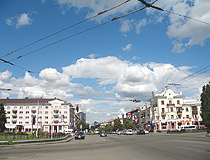
Wide street in the center of Chernihiv
Author: Natalochka Marchenok
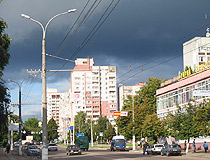
Apartment buildings in Chernihiv
Author: Natalochka Marchenok
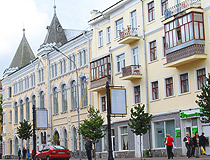
Philharmonic in Chernihiv
Author: Natalochka Marchenok
Chernihiv - Features
Chernihiv is one of the oldest cities in Ukraine. It is also the northernmost regional center of the country located on the right bank of the Desna River, not far (65-70 km) from the border of Ukraine with Belarus and Russia, at the same latitude as London (England) and Saratov (Russia). You can get from Kyiv to Chernihiv in 1.5-2 hours using numerous mini-buses. Urban transport is represented by mini-buses, buses, trolleybuses, taxis, and electric scooters.
The coat of arms of Chernihiv, approved by the city council in 1992, depicts a black crowned eagle with golden beak and claws and scarlet eyes and tongue holding a long golden cross in its left paw. In general, it repeats the historical coat of arms of Chernihiv adopted in the second half of the 17th century.
According to legend, Chernihiv was named in honor of the first local prince Chernyy. According to another legend, the city owes its name to the dark, dense, “black” (“chernyy”) forests that surrounded the original settlement on all sides. The exact origin of the city’s name is not known. The City Day of Chernihiv is celebrated on September 21. In 2001, the ethnic composition of Chernihiv was as follows: Ukrainians - 86.3%, Russians - 10.6%, Belarusians - 1.15%.
The city is located in a continental climate zone with short, moderately mild winters and warm, long summers. The warmest month is July with an average temperature of plus 18.7 degrees Celsius, the coldest month is January with an average temperature of minus 7.1 degrees Celsius.
Chernihiv is an important railway and highway junction of Ukraine. The leading industries of the local economy are chemical, light, food, building materials, and woodworking. Tourism is proclaimed one of the priority directions of socio-economic development of the city. The motto of Chernihiv is the slogan “Chernihiv - the City of Legends” depicted on the city’s tourist logo.
By the number of outstanding architectural and historical monuments Chernihiv occupies one of the first places among the cities of Ukraine. In Chernihiv you can find about 30% of all the monuments of the pre-Mongol period preserved in Ukraine. The main architectural sights of the city are 5 medieval churches of the 11th-13th centuries. Chernihiv also has a large number of monuments of the Cossack Hetmanate period constructed in the Cossack Baroque style.
Main Attractions of Chernihiv
Chernihiv Dytynets Park - the central and oldest part of Chernihiv located on a high ledge of the right bank of the Desna River valley. In the past, there were the main town fortifications here. The most significant monuments of history and architecture of Chernihiv can be found here (the Savior-Transfiguration Cathedral, the Cathedral of Saints Borys and Gleb, the Chernihiv Collegium, the Regimental Chancellery House known as Mazepa’s House). On the site of the former ramparts of the Chernihiv fortress, 12 cast-iron cannons of the 17th - early 19th centuries are installed. Preobrazhens’ka Street, 1.
Savior-Transfiguration Cathedral (1036) - a church-museum, which is one of the oldest surviving monumental stone buildings in Ukraine, an architectural monument of national importance. In the past, it was the main church of the Chernihiv Principality and the burial vault of local princes.
Cathedral of Saints Borys and Gleb (1120-1123). This cathedral has almost completely preserved the features of the 12th century architecture. Throughout its history, it has been repeatedly destroyed and rebuilt. In the 20th century, the restoration was carried out, which returned it to its old Russian appearance. An architectural museum is open in the premises of the cathedral. It also hosts sacred music concerts.
Chernihiv Collegium - one of the most beautiful buildings in the city, an architectural monument of national importance built in the Cossack Baroque style. It housed one of the first secondary educational institutions in Ukraine, founded in 1700. Children of the clergy, nobles, Cossacks, and burghers studied here.
Saint Catherine’s Cathedral (1715) - an architectural monument of national importance in the Ukrainian Baroque style, which can be found in the immediate vicinity of the Dytynets Park, one of the architectural dominants and symbols of Chernihiv. It was built in memory of the Cossacks of the Chernihiv Regiment, who took part in the assault on the Turkish fortress of Azov in 1696. Pidval’na Street, 5.
Church of Saint Paraskevi (Pyatnytska Church). This church was built near the town market at the expense of local merchants in the late 12th - early 13th century. It is named after Saint Paraskevi of Iconium, who, according to the Orthodox tradition, is the patroness of trade and merchants. You can find it in the very center of Chernihiv, behind Taras Shevchenko Chernihiv Regional Academic Music and Drama Theater (Krasna Square), on the territory of Bohdan Khmelnytsky Public Garden. Het’mana Polubotka St, 10/2.
Yelets Dormition Monastery - one of the first monasteries of Kyivan Rus’ founded in the middle of the 11th century. The Dormition Cathedral of the monastery was built at the beginning of the 12th century. This monument of architecture of national importance has almost entirely survived to our time, albeit with later layers in the Ukrainian Baroque style. Kniazia Chornoho Street, 1.
Holy Trinity Cathedral (1679-1695) - an architectural monument in the Ukrainian Baroque style built during the times of the Cossack Hetmanate. Its bell tower (58 meters high) is open to visitors. From its top you can enjoy the best panorama of Chernihiv. Tolstoho Street, 92.
Illinska Church - a monument of old Russian architecture of the 11th-12th centuries built on the southern slope of Boldina Mountain near the entrance to the Anthony Caves, which form a single complex of the former Illinsky Monastery. The total length of the caves is more than 300 meters. The largest underground church in Ukraine can be found here, with a height of 8.4 meters. Illins’ka Street, 29.
Chernihiv Regional Historical Museum named after Vasyl Tarnovsky - one of the oldest and most famous museums in Ukraine located in the historic building of the Governor’s House (1804-1820). The collection of this museum includes more than 130 thousand exhibits related to different periods of the history of the Chernihiv region including a rich collection of archeological finds, old books, rare documents, items of the Cossack era. Here you can get acquainted with examples of folk embroidery, weaving, woodcarving, ceramics, and folk clothing. Muzeina Street, 4.
Chernihiv Regional Art Museum named after Hryhoriy Galagan. In total, there are over 5 thousand exhibits here. The museum has departments of Western European art of the 16th - 19th centuries, Ukrainian and Russian art of the 17th - early 20th centuries, and the Soviet period. The collection of Ukrainian portrait painting is devoted to the development of this genre from the end of the 17th to the beginning of the 20th century. The department of folk toys has about 350 exhibits made of clay, wood, and straw. Muzeina Street, 6.
Chernihiv Museum of Military History. The exhibits of this museum tell about the participation of local residents in the Second World War, the defense and liberation of Chernihiv, partisans, the fate of prisoners, as well as the participation of Ukrainian peacekeepers in international UN operations. A separate exposition is dedicated to the contribution of city residents to the elimination of the accident at the Chernobyl nuclear power plant and its consequences. Also in the courtyard of the museum there is a small exhibition of military equipment. Shevchenka Street, 55?.
Glebov’s Estate - one of the most beautiful buildings in Chernihiv resembling a medieval castle. It was constructed in the neo-Gothic style and has a rather complex asymmetrical layout. The house was built by the Russian public figure and politician Grigory Glebov at the end of the 19th century. Shevchenka Street, 97.


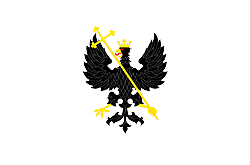
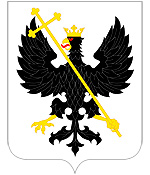



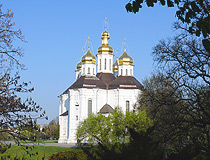
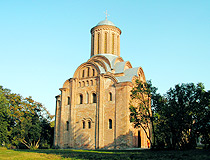
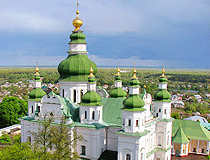
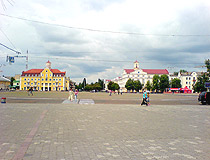
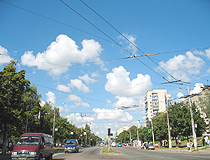
The comments of our visitors